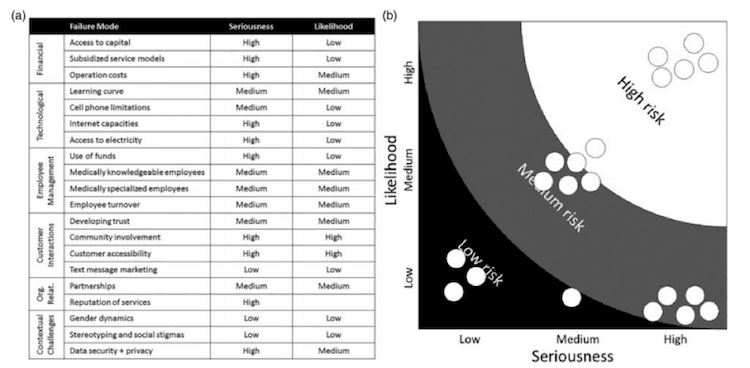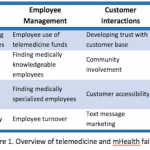Inspiration, Ideation and Implementation: How Design Thinking Can Build Robust and Sustainable mHealth Ventures
By leveraging the popularity of mobile devices and the power of global connectivity, telemedicine and mHealth ventures have the potential to improve the efficiency, accessibility and reliability of patient-centered care, particularly in developing countries with fledgling health care systems. Part one of this blog series discussed how the majority of mHealth ventures fail to survive beyond the pilot stage because they do not understand and meet the deeply felt needs, wants and interests of their customers. While ventures face a litany of technological, social, legal and economic challenges, part two of this blog series showed how developing strong value propositions can lead to viable business models. As was discussed, self-sustaining ventures tend to:
- Disperse costs of the services offered over time
- Be responsive to the local socioeconomic and cultural context
- Keep the technology and processes simple
- Appeal to a wide segment of the population (primary care for multiple demographics)
- Offer expertise wherever possible
- Scale up by strategically broadening facilities or services.
inspiration, ideation and implementation
Traditional businesses and entrepreneurial initiatives avoid similar failure modes and develop strong value propositions by studying customer needs and preferences—a step that helps create a customer-centric business model and inform the user experience. The philosophy and praxis of design thinking provide a structured process to evaluate novel concepts and gauge the success of new business strategies based on the (realized or unrealized) needs of the customer. The design thinking process is comprised of three phases: inspiration, ideation and implementation. The first phase, inspiration, involves developing a thorough understanding of the people, culture and society in which the product (and venture) is to function. During the ideation phase, insights into the specific workings of the target population are distilled and used to identify, refine and quickly prototype potential solutions. Finally, in collaboration with local partners, the product is introduced into the market during the implementation phase. By using design thinking, mHealth ventures can be more attuned to the value their product/service provides to customers, and can more effectively meet their needs.
This blog post summarizes how design thinking can be employed to develop, strengthen and validate value propositions and increase the likelihood of building successful, sustainable and self-sufficient enterprises. Specifically, we provide a structured framework that helps determine the viability of ventures during the initial conceptualization phase.
The design process presented here encourages the formation of multidisciplinary teams and research into the perspectives of end-users and other stakeholders in order to have a productive dialogue. That dialogue, in which different approaches are compared and refined, is captured in a way that leads to a clear course of action. In this design space, the stakeholder representatives critically evaluate their venture with common value propositions and common failure modes in the backdrop. The ventures being tested are developed, debated and refined using a risk scoring chart, which helps participants identify and address potential failure modes. At the culmination of a design session, team members have gained additional perspectives, refined their business model and identified questions that require further validation. Results may inform future design sessions.
Identifying Stakeholders
Among all the stakeholders, community representatives are most important, because they form the eventual customer base of the venture. They also provide insights into socio-economic realities, as well as cultural norms, beliefs and practices that can influence the outcome of the venture. Certain illnesses or symptoms may result in different health-seeking behaviors in patients. Sexually transmitted infections and family planning, for example, are often sensitive subjects that carry a social stigma. Community representatives can also inform the design team on the resources available to the average customer – a crucial piece of information considering mHealth technologies are affected by what types of phones, computer technology, internet access and electricity access are available in the target area.
Health care professionals and administrators are also vital to the design thinking process since they can offer a valuable perspective on patients’ health-seeking behaviors and inform the viability of the venture based on experiences with patients. Moreover, they have the opportunity to share information on how well new technology may fit into the existing clinical infrastructure, or how patients choose to invest (or sacrifice) their scarce resources for personal health care.
Venture champions also need to be identified, so that they can relay venture-related information to the community and provide key resources, as well as reinforce community feedback. They synthesize the knowledge of the other stakeholder representatives to develop a strong business model and implementation plan. They are also responsible for seeking funding sources for the venture, looking for additional beneficial partnerships and determining how the venture will ultimately work.
leveraging the Design Space
The diverse stakeholder perspectives come together to evaluate opportunities, synthesize strategies and develop implementation plans in the design space. The design space can be a physical space for in-person meetings, video conferences or phone calls; it may also be a metaphorical thinking space to evaluate new ideas. During the meeting, the venture champion first presents the initial venture concept. The team discusses research findings from each representative. Once all team members are on the same page, they identify potential benefits the venture could offer each stakeholder.
The stakeholder teams can use the design space to evaluate value propositions (based on stakeholder feedback) and to develop a value proposition that is well-defined, feasible and responsive to customer needs. To assess the viability of a venture, members of the stakeholder team use a risk scoring sheet and graph to rank the likelihood and severity of all possible failure modes (see the image below). If the failure modes form a high-risk cluster, then the direction of the venture may need to be reevaluated. If the failure modes are at a low- or medium-risk, then the stakeholder team must identify actionable steps that can be taken to avoid common failure modes and strengthen the venture strategy.

Validation and Next Steps
Throughout the design thinking process, it is important for the stakeholder team to iterate on the design of their venture in an attempt to move as many failure modes as possible to “low risk” areas of the risk graph. The team must ensure that value propositions are validated for the given context and that implementation strategies will be effective, by having robust business models, speaking with potential customers and revisiting market inputs on a regular basis. The team should end the session with a validated value proposition, a refined business model and a list of tasks that need to be accomplished to move the venture forward. Focus groups, interviews, prototype testing and other forms of market research will provide more information that may spur additional design sessions to further iterate on the approach.
While this framework is by no means a formula for guaranteed success, it provides a valuable tool that can be used to gather diverse stakeholder perspectives and convert qualitative ideas from these stakeholders into quantitative parameters and metrics with associated risk and uncertainty indices. With this method, key stakeholders are engaged from the start to identify value propositions relevant to the venture. They also provide the local knowledge and “know-how” necessary to forecast potential pitfalls and devise effective strategies to avoid (or handle) failure modes. Ultimately, using a design thinking framework can prime mHealth ventures to proactively conceptualize their value propositions and potential impacts on the community, meet customer needs, and shape a venture that stands the test of time and improves community health.
Note: This blog post summarizes a research article: Eckman, M., Gorski, I., Mehta, K. “Leveraging Design Thinking to Build Sustainable Mobile Health Systems,” Journal of Medical Engineering & Technology, Vol. 40, No. 7-8, pp 422-430, 2016.
Khanjan Mehta is the vice provost for Creative Inquiry and director of the Mountaintop Initiative at Lehigh University.
Main photo via Pexels. Homepage photo via UnSplash.
- Categories
- Health Care, Technology



